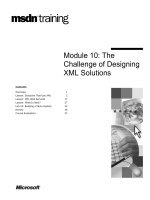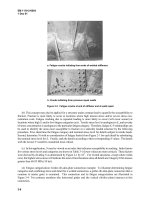Tài liệu Vietnam Investment Funds Review of Private Equity exits ppt
Bạn đang xem bản rút gọn của tài liệu. Xem và tải ngay bản đầy đủ của tài liệu tại đây (236.61 KB, 5 trang )
Page 1
Vietnam Investment Funds
Review of Private Equity exits
Grant Thornton Vietnam January 2011
Introduction
There is a perception by many in the market that
Vietnam’s private equity focussed investment funds
have difficulties in achieving exits from their
investments. With the tightening of capital markets
following the global financial crisis it is through exits
that fund managers have been able continue to make
new investments without raising additional capital. As a
result, the level of exits that have been actually achieved
by the fund managers is of significant importance to the
industry.
Grant Thornton Vietnam sought to bring clarity to
the true level of exit activity being achieved by
surveying the leading fund managers. Although
participation in the survey was voluntary, the fund
managers that participated provide a representative
sample of the leading managers, most with a well
established track record.
The survey was conducted in December 2010, and
includes data up to 30 November 2010. Questions
covered investments made, exits achieved, method of
exits and the length of time that investments were held.
For the purposes of the survey, a “private equity”
transaction has been defined as an investment in the
equity of a company in Vietnam, which is not listed or
in the process of listing, and where a minority
ownership position exists. This will often include
minority protection for investors and board positions,
however this will depend on each individual
investment.
Summary
Survey results show that the participating fund
managers have invested more than USD1.8 billion in
private equity investments in Vietnam since 2003, in
almost 200 companies. 2007 saw the largest number of
investments made, both in value and in number, with a
substantial decrease seen in the following years.
During 2003 - 2010, the period covered by the
survey, 150 full and partial exits have been achieved by
participating fund managers in Vietnam. The average
holding period was approximately three years for each
full and partial exit achieved. The average holding
period has been trending upwards over the survey
period, with exits in 2010 taking, on average, between
four and five years.
Stock exchange listings have continued to be the
predominant method used by fund managers for exiting
from their investments, accounting for over 60% of all
exits.
Fund Manager
First year
established
Active
investment
funds
Funds
managed
(USD
millions)
Dragon Capital 1995 8 1,000
Indochina Capital 1999 8 545
Mekong Capital 2002 3 150
Prudential Vietnam 2002 3 1,300
VinaCapital 2003 6 1,730
BankInvest 2007 2 250
AIM Capital Management 2009 2 18
Participating
Fund Manage
rs
Page 2
0
100
200
300
400
500
600
700
800
2003 &
prior
2004 2005 2006 2007 2008 2009 2010
YTD
$million
0
10
20
30
40
50
60
Total value of PE
investments made
($millions)
No. of PE
investments made
Vietnam Investment Funds – Review of private equity exits
Value and number of private equity Investments
The value of private equity investments made by the
survey participants between 2003 and 2010 exceeded
USD1.8 billion, accounting for almost 200 individual
investments.
The peak year for investments was in 2007, where
more than USD750 million was placed into private
equity investments, 2.5 times the value than in any
other year in the survey period. Following the 2007
peak, we have seen a dramatic drop-off in the value and
volume in private equity investments made. This is a
reflection of the constraints in the capital markets in
raising funds following the global financial crisis and
domestic market issues that arose in Vietnam following
the global slowdown.
With recoveries in global markets and the continued
strong domestic growth in Vietnam, fund managers
have been actively promoting their new investment
funds to global investors. They appear poised to have
fresh capital to underpin an upswing in private equity
investments in the near term.
Exits
Fund managers have achieved an equal spread between
the number of full and partial exits since 2003. 2007
was the largest year for exits, with USD292 million in
value and 40 exits achieved.
The number of exits, when compared with the
number of investments made, show that there is a build
up of private equity investments that are still seeking an
exit opportunity, and particularly those requiring a full
exit, in Vietnam.
Private equity investments made in 2007, the peak
year, are only now being readied for exits by many fund
managers. The survey shows an average holding period
of approximately three years. Current trends show this
is moving towards an average holding period of four to
five years. Therefore we would expect that 2011 and
2012 will result in larger values and volumes of exits by
fund managers.
Year
No. of investments
made
Total value of
investments
($millions)
2003 & prior 31 281
2004 14 71
2005 30 207
2006 35 220
2007 55 752
2008 16 197
2009 8 60
2010 (Nov) 8 71
Year
No. of
full exits
achieved
No. of
partial exits
achieved
Total value of
exits
achieved
($millions)
2003 & prior 1 0 3
2004 1 4 47
2005 7 4 47
2006 5 7 135
2007 18 22 292
2008 13 14 230
2009 18 16 242
2010 (Nov) 12 9 150
Total value vs. number of PE investments
Value and number of PE investments made
Value an
d
number of PE exits
Total value vs. number of PE exits
0
50
100
150
200
250
300
350
2003 &
prior
2004 2005 2006 2007 2008 2009 2010
YTD
$million
0
5
10
15
20
25
Total v alue of ex its
achiev ed ($millions)
No. of full ex its
achiev ed
No. of partial exits
achiev ed
Page 3
0%
20%
40%
60%
80%
100%
2003 2004 2005 2006 2007 2008 2009 2010
YTD
Listing
Trade Sale
Secondary Sale
Sell back to Sponsors
Wind down / liquidation
Other
0
10
20
30
40
50
60
70
80
2003 &
prior
2004 2005 2006 2007 2008 2009 2010
YTD
months
Average length of time
invested (months) for
each partial exit
Average length of time
invested (months) for
each full exit
Vietnam Investment Funds – Review of private equity exits
Exit methods
Stock exchange listings are certainly the most favoured
method of achieving an exit for fund managers in
Vietnam. They account for almost twice the number of
exits compared to all other methods since 2003. Each
of the other methods of achieving exists have generally
remained relatively insignificant, other than for a few
spikes in 2005 and 2006.
In 2010 we saw an increase in the number of
secondary sales (sales to other fund managers).
Especially as new entrants sought to take a cautious
path and invest in targets that had already been vetted
and invested in by experienced fund managers. We also
saw trade sales drop off completely in 2010. This
presents fund managers with a challenge, as trade
buyers traditionally make up a large portion of buyers
for private equity exits in a global context.
Listings will likely continue to be the preferred exit
method for private equity investments in Vietnam. This
is due to the relatively lower barriers to list and the less
onerous compliance requirements for listed companies
in Vietnam.
Length of time invested for each exit
Survey data shows that the average length of time that
the investment funds remain invested in a company
prior to an exit (full or partial) has been trending
upwards in Vietnam. The 2010 data indicates an
average holding period of around four to five years.
Over the full survey period the average length of time
that investments have been held is three years.
The data suggests that the length of time an
investment is held is not significantly different between
partial and full exits.
It is often argued that investments take time to
mature in Vietnam, supporting the relatively equal
number of partial to full exits recorded. Partial exits, in
this context, appear to be used to free up investment
capital whilst the investment is still maturing.
Based upon the large number of investments made
in 2007, the next two years should result in a large
number of investment exits by the fund managers.
Year
Average length of
time invested
(months) for each
partial exit
Average length of time
invested (months) for
each full exit
2003 & prior 0 73.0
2004 28.4 2.0
2005 7.5 47.9
2006 36.9 51.8
2007 38.1 33.6
2008 26.6 45.7
2009 44.4 37.8
2010 (Nov) 52.3 65.5
Exit methods
Average length of time invested
Average length of time invested
Page 4
Vietnam Investment Funds – Review of private equity exits
Case studies – successful exits from
participating fund managers
Mekong Enterprise Fund invested
in Saigon Gas in November 2005,
the first consumer-focused
investment by Mekong. At the time,
one of the attractions was that
Saigon Gas’ business model, LPG distribution and
branding, was a model which had an extensive track
record of M&A and industry consolidation in most
Asian countries. Typically the industry begins highly
fragmented, but eventually through M&A 2-3 leaders
consolidate the industry and enjoy the scale
advantages of doing so. Mekong achieved a gross
return multiple of 2.0x and a gross IRR of 25.9% on
the investment
Mekong Enterprise Fund II
invested in Golden Gate in April
2008, at a time that the company
operated around five restaurants
under the Ashima brand. Mekong
Capital worked closely with the
company to align around a five-year vision, develop a
plan for achieving that vision, and implement the plan.
Within two years, Golden Gate had scaled up to around
30 restaurants under the Ashima and Kichi Kichi brands,
while maintaining attractive net profit margins.
Golden Gate hired a local advisory firm, TNK Capital, to
find potential buyers for a secondary transaction for a
minority stake. The deal was completed in October 2010,
resulting in a gross return of 3.7x and gross IRR of
72.7%.
Vinamilk is the country’s flagship
corporate and its leading dairy-
products manufacturer. Dragon
Capital was involved very early in
the equitisation process, having advised on the
roadmap for privatisation and listing when the
company was still an SOE. Dragon was the first
foreign investor in the company, and joined the
Vinamilk Board after the IPO. It has been an active
Board member since. Recently, Dragon Capital
decided to make a partial exit from Vinamilk via an
open auction to foreign investors. The exit tranche
was about 1% of the company and 12% of its stake.
The $19m deal resulted in an exit multiple of 5.1x
and an IRR of 39% over six years.
In March 2010, Dragon
Capital sold its VP Bank stake
at a 30% premium to its
carrying value. Dragon Capital
acquired 10% of VP Bank as a
strategic investment in 1996. A partial exit occurred in
2007 when bank valuations soared, and VP Bank shares
hit 10x book. The balance of Dragon Capital’s stake
was sold in March 2010 at a valuation of approximately
2.5x book. In total, the investment achieved a 2.7x
multiple and an IRR of 21%. VP Bank is typical of an
investment where Dragon Capital applied hands-on
intervention to preserve shareholder value.
In July 2006, VinaCapital
purchased a 17.5% stake in the
Hilton Hanoi, a five-star, 271-
room hotel located across from
the Hanoi Opera House in the
centre of Vietnam’s capital city. Together with a
52.5% stake owned by VinaLand Limited, the two
VinaCapital-managed funds held a controlling 70
percent stake in the hotel.
The sale of the equity stake resulted in an IRR of
26% over the three years the stake was held.
VinaCapital sold its
position in Masan Group, a
diversified food products
company that owns well-
known fish, chilli and soy sauce brands such as Chinsu.
The sale of the equity stake was at a price 81% above
the book value of the position in the VOF portfolio.
The sale achieved an IRR of 83% and multiple of 2.8x.
VOF had held Masan for 33 months.
Page 5
Grant Thornton Vietnam is a full service Auditing and Advisory firm, originally established in Vietnam in 1993.
We provide a wide range of services to the fund management sector, including:
• Audit and Assurance
• Taxation and structuring advice
• Transaction advice (including buy-side and sell-side M&A support)
• Independent Due Diligence reviews and reports
• Strategic and Corporate Governance reviews
• Diagnostic and performance reviews
• Feasibility studies
• Valuations
• Internal audits and control reviews
For further information or assistance, please contact:
Ken Atkinson
Managing Partner
T +84 8 3910 9100
E
Matthew Lourey
Advisory Services Director
T +84 8 3910 9149
E
Nguyen Thi Vinh Ha Ronald Parks
Audit Partner Tax Partner
T +84 4 2220 2630 T +84 8 3910 9100
E E
Alan Dy
Audit Partner
T +84 8 3910 9191
E
Grant Thornton (Vietnam) Ltd offices:
Hanoi
8th Floor Vinaplast-Domus Building
39A Ngo Quyen Street
Hoan Kiem District
T +84 4 2220 2600
F +84 4 2220 6449
Ho Chi Minh City
28th Floor Saigon Trade Center
37 Ton Duc Thang Street
District 1
T +84 8 3910 9100
F +84 8 3914 3748
www.gt.com.vn
© 2010 Grant Thronton (Vietnam) Ltd. All rights reserved.
Grant Thornton Vietnam is a member firm within Grant Thornton International Ltd
(“Grant Thornton International”). Grant Thornton International and the member firms are
not a worldwide partnership. Services are delivered by the member firms
independently. This publication is general in nature and should not be construed as
providing advice. No responsibility is taken for any party acting on the contents of this
document.









